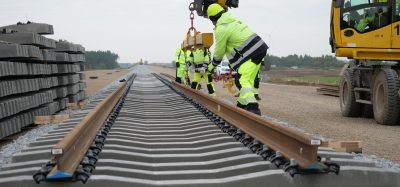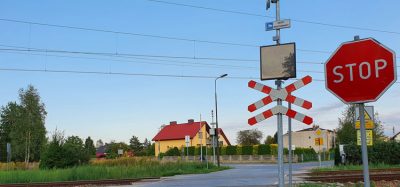Talgo: at the forefront of high-speed railway technology
Posted: 21 July 2009 | | No comments yet
The effect of implementing a high-speed network in Spain has been incredibly positive and it has created a ‘before and an after’ effect in the Spanish railway sector. Not long ago, trains were competing against cars, but nowadays trains are in competition with planes and this radical change shows the technological jump that the railway sector is going through thanks to high-speed worldwide.
The effect of implementing a high-speed network in Spain has been incredibly positive and it has created a ‘before and an after' effect in the Spanish railway sector. Not long ago, trains were competing against cars, but nowadays trains are in competition with planes and this radical change shows the technological jump that the railway sector is going through thanks to high-speed worldwide.
The effect of implementing a high-speed network in Spain has been incredibly positive and it has created a ‘before and an after’ effect in the Spanish railway sector. Not long ago, trains were competing against cars, but nowadays trains are in competition with planes and this radical change shows the technological jump that the railway sector is going through thanks to high-speed worldwide.
Talgo has always been at the forefront of railway technology and today it has become the Spanish reference in the high-speed selected club of manufacturers. Although a reality today, the challenge of high speed has always been on Talgo’s horizon for many decades and the result of its constant innovative efforts and investment in R&D paid off in 2001 by winning a contract to supply Renfe Operadora with 16 Talgo 350 high speed trains for the Madrid-Barcelona line. Some years later, in 2005, Talgo was again awarded a contract in another international tender launched by Renfe Operadora to supply 30 additional Talgo 350 train-sets and, thus, making Talgo the number one supplier of high-speed trains in the Spanish market.
The Talgo 350 and the Talgo 250, known among railway fans as the Duck and the Little Duck respectively, are clear examples of the advantages of the Talgo technology – low energy consumption thanks to the lightweight construction in aluminum, high level of passenger safety and comfort thanks to the articulated concept and greater interior space in the passenger coaches, environmentally friendly with minimum acoustic contamination and perfect adaptability to any track gauge thanks to the independent wheel and guided axle system, panoramic windows and a unique accessibility thanks to the 100% low-floor coaches, great flexibility and modularity to adapt to different markets and their requirements, and extensive experience in maintenance services, where Talgo is a pioneer company.
In order to know more about Talgo, it is important to understand Talgo’s constant innovative nature. On 21 August 1941, a Spanish engineer, Alejandro Goicoechea, successfully carried out tests on a unique axle guidance device for use in rolling stock, composed of an articulated rolling frame formed by isosceles triangles. The base of each triangle was an axle with two independent wheels and the upper apex of each triangle was assembled in the middle of the previous triangle base. It was hauled by a steam locomotive reaching a speed of 75km/h on the Leganés-Villaverde line, in Spain.
José Luis de Oriol y Urigüen felt confident about the feasibility of Goicoechea’s idea and in October 1942 he established Talgo (Tren Articulado Ligero Goicoechea Oriol). From the beginning, it has been a company whose activities include all stages of the production process: design, manufacture and maintenance of its own rolling stock. This integration has allowed a focus on the entire technological cycle, optimising safety standards and passenger comfort. In short, the Talgo philosophy could be summarised as follows: safety in running operation, simplicity in the design and economy in manufacturing, in operation and in maintenance.
The evolution of the Talgo Train
The original idea upon which the development of the Talgo trains was based is the replacement of the conventional, 26m-long coaches with two bogies by shorter carbodies, supported at the rear on two independent wheels and at the front end centrally on the rear part of the preceding coach. A sequence of virtual triangles is built whose vertexes are connected to the base centre of the preceding triangle, being at the same time a support and a traction point. Through this arrangement a triangle steering system is achieved. As a consequence of it, the wheels run parallel to the rails and, in curves, the wheels which run on the outer rail have a negative angle of attack.
In order to demonstrate the feasibility of this idea, a sequence of short triangular structures was built, consisting of no more than flanged wheels mounted on slightly cranked axles, and joined by light girders making up the other two sides of the triangle, which was hauled by a locomotive reaching a speed of 75km/h. The possibility of constructing light rail vehicles which provide traction energy savings and reduce damage to the track had been proved.
Talgo 350: very high-speed train
In 1988, Patentes Talgo initialised their high-speed project by adapting the Pendular tilting train that had been carrying out tests between Boston and New York.
Between October and November of the same year, its six cars underwent tests in Germany and Austria and reached 291km/h. Further tests were performed with complete stability and they reached the maximum speed allowed in a static test bench in Munich: 500km/h, with very high safety levels.
These achievements served as real encouragement for Talgo engineers to continue with the project. After equipping these cars with primary suspension, in May 1994, they were able to run at 304.6km/h on the Madrid-Seville AVE line.
The following November, once again in Germany, it reached 360km/h between Hannover-Wurzburg, the maximum speed allowed with overhead power cables. Finally, in September 1997 and again on the AVE line, the train with the improved suspension system reached 333km/h, which gave complete satisfaction to all. A 100 series locomotive was coupled at the tail end.
In April 1998 with all the positive test results, Patentes Talgo developed a high-speed locomotive to participate in the tender launched by Renfe for the new Madrid-Barcelona-French border AVE line.
The locomotive’s singular design did not go unnoticed. It was decorated in the light blue and white colours and the large-sized characters of its denomination, Talgo 350 (named as S-102 and S-112 by Renfe Operadora), were painted on both sides in allusion to the speed it could reach.
To verify the travelling parameters of the train on the new AVE line that was still under construction, Talgo carried out a series of simulations to check the journey times in various conditions. With a train comprising 11 cars, at a maximum speed of 350km/h and with three stops each of one minute, the journey time was 2 hours and 2 minutes in ascending direction and 2 hours and 3 minutes in descending direction.
The first track tests were carried out on the Madrid-Seville line from September onwards and on 24 February 2001, 359km/h were reached, thus obtaining a new speed record in Spain.
16 October was a memorable date for this train as HRH King Juan Carlos I supported the research efforts made by Talgo when he went aboard to cover the stretch between Bujaraloz and Vallmanya. The journey took approximately 45 minutes and the train reached 350km/h inside the Hechiceras tunnel that measures 3,800m. However, on 11 October, a few days before, it had reached 362km/h.
After the Royal visit, the train was sent to the Madrid-Chamartin Station to be exhibited together with the most prestigious high-speed trains in Europe during the 4th Eurailspeed 2002 World Congress.
Being able to run a commercial service at 350km/h, the train would have to reach a further 10% of the speed, i.e. 385km/h, although the purchase contract stipulated that the trains should reach 330km/h at maximum speed and be able to cover the distance between Madrid and Barcelona in 2 and a half hours, at an average speed of over 300km/h.
The train, due to its characteristic aerodynamic profile, was soon named ‘the duck’ because the shape of the front was like the beak of a duck.
The specifications were that the first train of the first series (S-102) was delivered October 2003 and the rest of the order after March 2004, at a frequency of one train every two months, up to completing the order of 16 train-sets in December of that year and fully complying with the delivery terms agreed with Renfe Operadora.
Tests
During the tests that the trains went through in July 2004, they reached a speed of 300km/hr on the Madrid-Lérida AVE line, using ERTMS Level 1.
26 February 2005 was the day chosen by Renfe Operadora for the start of commercial services with these trains between Madrid and Lleida although, due to the state of the signalling system, they were only authorized to travel at 200km/h. Once in service with ETCS Level 1, the speed began to be gradually increased to 250, 280 and 300km/h whereas to have started at 330km/h would have obliged using the ETCS2system on this line.
On 28 April, the traversing radius was extended by allocating the Madrid-Huesca journey in replacement of the Talgo Pendular Altaria, which had undertaken this route until then.
As all the services offered did not keep the whole park in active service, some compositions were allocated to continuing with the tests. This happened to the 002 train, which was used in driving and braking tests at 330km/h. The 003 was used in dynamic tests and reached 363km/h and the 005 which had been travelling daily at 300km/h between Gavilanes-Ciudad Real and Guadalajara-Medinaceli (overnight) to reach the 100,000km mark at that speed.
Today, the Talgo 350 fleet of Renfe Operadora (S-102 and S-112) is covering practically all high-speed destinations in Spain providing a state-of-the-art service to passengers with a unique punctuality comprise of 100% refund of tickets with delays of more than 5 minutes.
Talgo 250: high-speed train
The Talgo 250 was originally developed to meet Renfe’s needs to operate the latest generation of high-speed trains in an indistinctive manner within the Spanish rail network. It is important to bear in mind that Spain’s traditional gauge is 1668mm with the electric supply in 3000 kV DC while the existing high-speed lines have been designed and built in the 1435mm standard gauge and 25 kV AC current supply. Thus, we can say that Spain is one of those unique countries with two different systems in terms of gauge, electric supply and signalling within the same network and Talgo has been able to provide a solution to this ‘uniqueness’. The Talgo 250 meets all these requirements: dual voltage (AC-DC), multiple signalling systems and variable gauge system ‘Talgo RD’ to be able to run on both gauges with a total adaptability.
Renfe’s version of the Talgo 250, named as S-130, is composed on two power heads and eleven intermediate coaches with a total length of 185 meters. The total passenger capacity of this version is of 299 passengers although, due to the high flexibility of this train, this capacity can be increased or reduced according the needs of other operators. The power heads incorporate traction equipments and the intermediate coaches use Talgo’s main technological principles of aluminium welded body shells, articulated union between cars, independent wheels, permanently guided axles and natural tilting system. The Talgo 250 has been designed to run at speeds of 250km/h on the 1435mm high speed lines on AC current and 220km/h on the 1668mm conventional network on DC current.
And there is more to come soon…
Talgo’s efforts in R&D continue to meet with the market’s future requirements in high-speed trains and maybe as soon as April, Talgo will show the world its very latest design of a high-speed platform which will combine Talgo’s main technological principles and the most modern technologies with railway applications. But the railway sector will have to wait a few more months – but it will be worth while…
Global Railway Review Autumn/ Winter Issue 2025
Welcome to 2025’s Autumn/ Winter issue of Global Railway Review!
The dynamism of our sector has never been more apparent, driven by technological leaps, evolving societal demands, and an urgent global imperative for sustainable solutions.
>>> Read the issue in full now! <<<







